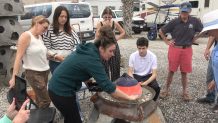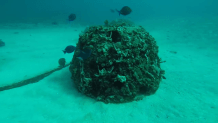When 69-year-old Mary Agnes Vodde-Hamilton died unexpectedly last year, her children weren't sure how she wanted to be interred.
Her last Facebook post, though, told them exactly what she wanted.
The last thing Kailey Newkirk's mother posted to Facebook included a link to Florida-based charity Eternal Reefs.
The group partners with families to incorporate cremated remains into structures known as reef balls, which are then placed on the ocean floor to support coral reef growth and underwater sea life while creating a living, underwater memorial.
Get Connecticut local news, weather forecasts and entertainment stories to your inbox. Sign up for NBC Connecticut newsletters.

“Eternal Reefs is a cremation memorial option that is intended to help to protect, preserve and enhance the marine environment for future generations,” CEO George Frankel said. “And we use memorialization as the tool to build these public reefs."
Reef balls are used worldwide to restore coral reef beds damaged by overfishing, ocean acidification, and coral bleaching. The Reef Resilience Network estimates that more than 75% of coral reefs in the Atlantic Ocean and over 50% of coral in the Pacific are currently threatened.
U.S. & World
Coral reef degradation in turn threatens marine ecosystems around the world, as the EPA reports 25% of all marine life is dependent on coral reefs at some point in their lifecycle.
Newkirk clicked the link her mom shared and read up on the untraditional approach. She immediately loved the idea.
“She was trying to save literally everything in the world, even on her way out of it."
Kailey Newkirk

(Courtesy Kailey Newkirk)
Although the idea seemed perfect to Newkirk, she knew the approach would be a departure from tradition for her family, who had always honored their loved ones through traditional Irish Catholic funerals known for open caskets and solemn music.
In stark contrast, Eternal Reefs is centered on helping the end of one life support the birth of new life in a positive, celebratory way.
Celebrating life
The Eternal Reefs approach combines a cremation urn, ash scattering, and a burial at sea into a distinctive tribute to the life being honored.
The memorialization process -- as the group refers to its multi-day, interactive approach to interring a loved one's remains at sea -- is about four days long and involves the family at every step, including the incorporation of the remains into the reef ball.
Generally, families gather over a long weekend at one of the coastal locations where the reef balls are finished before being placed in the water.
Families first create the “pearls” of the reef ball, or the top rings, by mixing in some or all of the remains with the concrete.
“Everyone in the family who wanted to took a turn pouring some of my mom's remains in, mixing it into the cement,” Newkirk said.

The "pearl" is then added to the body of an already-cast reef ball.
Many families also use the day to decorate the reef ball with tributes to their loved ones.
“We provide the family with children's sidewalk chalk and rubbing wax and paper and they can draw all over,” Frankel said. “Little kids will climb inside the reef and write on the inside of the reef. It's a very, very positive process.”
Newkirk's family chose to decorate the reef ball with mementos, handprints and stones.

While the "pearl" is cemented down into the center of the reef ball, the families have a day to enjoy the nearby beaches or reminisce in each other’s company. Newkirk says her family used the time to look at photos of her mother, share fond memories and process their grief together.
Families gather the next day for a viewing of the finished reef ball. If the person served in the military, those honors take place that day.
On the final day, the Eternal Reef memorial is placed on the ocean floor.
The family and the reef coordinators travel by boat to a designated location off the shoreline. The reef ball is then placed alongside other reef balls, to create a “reef patch,” where it can immediately become a place for ocean life to thrive.
To date, more than 3,000 Eternal Reefs have been placed in about 25 locations off the coasts of Florida, Maryland, New Jersey, North Carolina, South Carolina, Texas and Virginia.
Knowing that necessary new life will be brought to these areas of the ocean brought Newkirk peace and purpose during the process, Newkirk said.
“It feels intimate without being overwhelming and it feels celebratory without being weird."
Kailey Newkirk
The multi-day process gives space for families to grieve and rest in between each event. It can also be especially useful in introducing young children to loss for the first time.
“A lot of parents over the years have told us, ‘This is the best way I could have thought to introduce my child to a loss because there's no open hole in the ground. There's no quiet room where everybody's talking in whispers,’” Frankel said. “This is an arts and crafts project.”
As a final touch to the memorial, Eternal Reefs gives each family a plaque with the exact coordinates of their loved one’s reef. Frankel says many families choose to revisit the spot over the years.
Similar hollow structures with circular cutouts have been placed by environmental groups in every ocean, making them the “international gold standard” for designed reef systems, Frankel said.

Creating a coral reef
Reef balls are hollow structures made of pH-neutral marine-grade concrete weighing up to 4,000 pounds. Each one has circular cutouts and is designed to mimic a natural reef system, according to the Reef Ball Foundation.
The structures are placed in groups of about 10 reef balls at specific coordinates within the entire reef site. Reef coordinators work to ensure the placement of the balls allow animals that live in the site to feed on open sand.
Though their distance from each other varies, each reef site contains its own patchwork of ecosystems.
Eternal Reefs says it has created about 32 reef sites with 3,000 memorials along the Atlantic and Gulf coasts, covering nearly half an acre of ocean floor. The Reef Ball Foundation, an international advocacy group for the technology, says there are over 500,000 reef balls in use worldwide in more than 62 countries.
Although the time it takes for life to migrate to the reef ball slightly varies depending on the location, the process generally happens very fast. The reef balls eventually become home to a wide range of marine life, from coral and algae to fish and sea turtles.

“Fish will migrate onto these as we are putting them in the water,” Frankel said. “I've been on a research vessel where we put a reef down and they have technical equipment and we could watch the fish come off other reefs and say, ‘I got a new home, nobody else is here. I'm first in the community.’ So we see that very quickly.”
The actual growth on the reef ball is mostly dependent on the time of year. That growth process has been sped up, though, due to Eternal Reef’s decision to add texture to the outer layer of the reef ball. The variance in texture allows microorganisms to propagate before they’re fed on, which Frankel says can result in seeable growth within six weeks and meaningful growth in two to three months.
All of this restores some balance as the world struggles with decimated habitats and climate change. Mass coral reef extinction is expected to threaten human lives as well as those of sea-dwelling animals, as coral reef beds act as natural barriers between shorelines and dangerous storm surges.
As climate change brings higher sea levels, more extreme storms and flooding, environmentalists say restoring coral reef systems is critical to mitigating damage to coastal communities.
How it started and where it’s going
In the 1980s, a group of divers from the University of Georgia were diving in the same Florida Keys spots they had the year prior.
“They literally could see the degradation of these reefs from one dive experience to the next dive experience,” Frankel said. “And they decided they wanted to do something about it.”
Their solution: reef balls.
Like any innovation, the idea went through bouts of trial and error. Thanks to a collaboration between the University of Georgia, Nationwide Artificial Reef Coordinators and the Florida Institute of Technology, a prototype was made -- the same ball that is now widely used to restore endangered aquatic environments, including coral reefs, oyster beds and mangroves.
One of the divers involved in the creation of the reef ball, Don Brawley, worked for Frankel as a part of another business venture. Brawley told Frankel about his intention to memorialize his father-in-law using a reef system upon his death.
“His father-in-law didn't want to be in a field with a bunch of old dead people and really wanted to have all this life and action going on around him,” Frankel said.

At the time of the conversation, Frankel had been placed in charge of managing his own family’s funerals, most of which had followed a traditional approach. But after his brother was diagnosed with a terminal illness and cremation was on the rise, Frankel knew there had to be a better way to honor people in their passing.
Frankel told Brawley that he’d like to seriously consider developing the idea into a viable business.
As they worked to create a business model, their first approach involved trying to get involved with the funeral industry, which was dealing with a substantial loss in revenue due to the cultural shift from traditional burial to cremation.
Despite Frankel feeling Eternal Reefs had the capacity to help replace some of that loss, the funeral industry was not quick to accept his proposition.
“The real issue was, ‘Who is this guy, George Frankel, walking into my funeral home, telling me he's got this whole new concept about this reef stuff?’” Frankel said.
In the wake of rejection, Frankel made the decision to pivot and appeal to the consumer directly. That decision turned out to be “one of the smartest” things they’d done, he said.
“People were no longer seeing the value in a casket that cost $4,000-$6,000 that they would see for an hour and would spend the rest of eternity in the ground in a concrete vault."
George Frankel
The pandemic was the next notable jump in growth.
For the first time in recent memory, everyone was forced to "see their own mortality," Frankel said. Eternal Reefs saw a rapid change in the conversations people were having about death, shifting the overall narrative and causing the group's information requests to triple.
Privately funding a public reef
Despite the organization marketing memorial services to families, Frankel says Eternal Reefs, is at its core, a reef-building operation. Partnering with the public allows the group to fund their reef projects along the eastern seaboard while providing an invaluable service to mourning families. In turn, families are able to participate in critical environmental restoration at a grassroots level.
“They’re essentially environmentalists, right?” Newkirk said about Eternal Reefs. “They're supporting marine life habitat, and they've figured out a way to crowdfund that.”
This privately funded yet public reef may be beneficial to all, but it would not be possible without tedious attention to detail, especially when it comes to permits.
Every action taken by Eternal Reefs must receive permits from various departments, all based on the location and time. Depending on the reef site, Frankel says there could be up to 26 local, state and federal agencies that have to sign off.
By partnering with reef coordinators across different states and jurisdictions, Eternal Reefs utilizes recreational reef sites with permits that help everyone profit. Families have a profound memorial experience, while governmental agencies and oceanside communities reap the benefits of a revamped reef system without the expense. Eternal Reefs, in turn, is able to continue producing and deploying reef balls.
The partnership means those coordinators can tell their bosses, “We just built a reef and it doesn’t cost us anything,” Frankel said.
When searching for an area they’d like to acquire a permit and place reef balls, Eternal Reefs looks for 30 to 60-foot areas relatively close to shores in common vacation locations that have relevant equipment nearby.
The group says they document all parts of the process and have all necessary permits.
“Everything is on the charts and we have to work within those constraints. This is why we consider ourselves reef builders more than we are any part of the funeral industry.”
Erin Panell contributed to this story.



